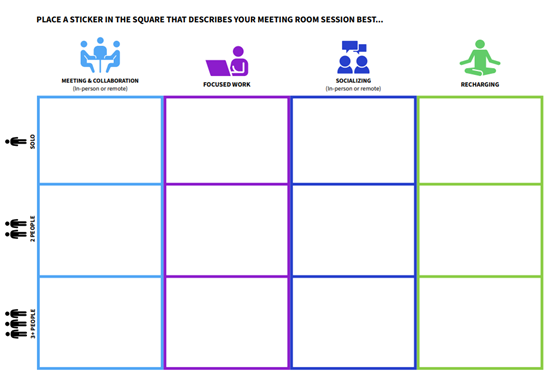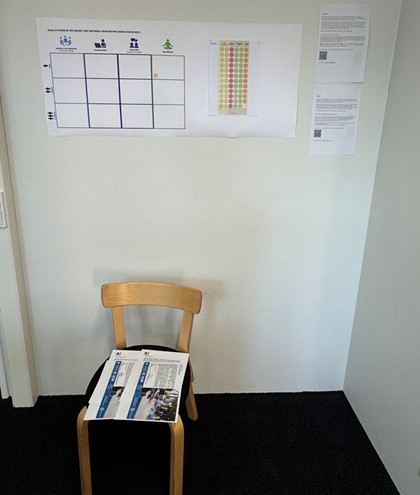Meeting rooms are a common example of shared space in office and university settings and thus have been identified as an area of opportunity for resource efficiency improvements. And while sensor data and booking data explain when these spaces are being used, they fall short of explaining how. To fill this gap in understanding, we tested a simple, interactive data collection method known as a ‘dot survey’ in a coworking building/startup community located on Aalto University campus in Otaniemi called A Grid. The dot survey is part of the Resourceful sharing project, which aims to foster co-usable learning and innovation environments. The project partners are Aalto University, Aalto Campus & Real Estate, University of Helsinki, and City of Helsinki.
In a coworking space like A Grid, it is important to understand how the meeting rooms are being used, yet confidentiality and privacy make that difficult. A Grid has multiple types of users utilizing 20+ meeting rooms, resulting in usage that goes beyond simple work meetings. This is reflected in the meeting room supply. For example, some meeting rooms are furnished with beanbags and movable furniture to create a casual or creative environment. Additionally, telephone-booth style pods are available throughout the building to accommodate for single usage rather than entire meeting rooms being booked for one person. But does actual usage reflect the intended purpose of the supply? To get insight into this, we have implemented dot surveys as a supplement to other forms of data collection.
We chose to utilize a dot survey because it is engaging and immediate. The design is simple: users place a dot sticker on a survey poster that represents their usage.
Our survey poster graphic is pictured in Figure 1 (on the right). We chose 9 locations for the dot surveys by categorizing the meeting rooms by floor, building section, and intended use.

The intended use categories are as follows:
– “Average” meeting rooms contain a monitor, table, and chairs.
– “Social” meeting rooms contain movable furniture such as beanbags and no large meeting room tables.
– “Hybrid” meeting rooms contain a mixture of both a large meeting room table as well as social features such as beanbags, armchairs, and in one case a meeting room table that becomes a billiards table.
We also felt it was important to represent different user types with different colored stickers, as an individual’s affiliations influence broader campus access possibilities and therefore might affect meeting room usage.
Finally, the building users were notified of the timeline for these surveys (three weeks), simple directions, and important data usage information. Physical copies of directions and important data usage forms were also printed out and provided in each room containing a dot survey.
The setup of a dot survey in the meeting room (including one seed sticker that is later removed from data) is pictured in Figure 2 (on the right).

Over three weeks, 62 “dots” were collected from the surveys. It is important to note that our usage of the dot survey method was unmonitored, as the nature of meeting rooms is that they are private spaces. Therefore, this approach is only meant to be exploratory in order to supplement our understanding of the building and its shared space usage.
One interesting result was that the “social rooms” did not have one instance of being used for “socializing”. Instead, these rooms were the most popular choice for recharging among the three room use types, while still the majority of use was for meetings. And despite the abundance of meeting rooms with various layouts, the primary use is exactly what their name implies- meeting rooms are largely used for meetings. While this might be self-evident, it is still an interesting point for additional inquiry into what else is required beyond the provision of space to encourage more “human-centric” usage such as socializing or pursuing personal well-being.
Text: Kelly Purcell and Tuuli Jylhä, Aalto University.
Resourceful sharing project is co-funded by European Union. Please find more information on the project HERE.